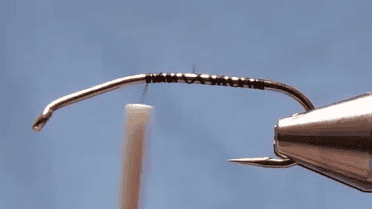Fed’s Guinea Dragonfly Nymph
As winter settles in across Australia, stillwater fly fishers turn their attention to patterns that entice sluggish trout. This month’s featured fly, the Guinea Dragonfly Nymph, is a proven performer, especially when fish are seeking substantial prey.
The Guinea Dragonfly Nymph is a modern take on a classic pattern originally designed by Kevin Longard of British Columbia, who once operated Skagit River Flies. Longard introduced this fly on his VHS tape, Flies of BC, showcasing its effectiveness in imitating the darner family of dragonfly nymphs. These nymphs are known for their elongated bodies and aggressive predatory behaviour, making them a significant food source for trout in stillwaters.
Phil Rowley, a renowned stillwater fly fishing expert, adopted and adapted Longard’s design, creating what he calls the “Guinea Dragon.” Rowley’s version maintains the essence of the original while incorporating materials and techniques that enhance its performance and ease of tying. He has featured this pattern in his educational materials, emphasising its effectiveness and simplicity.
Our featured fly this month is Paul Fedeles’ unique variant. Embracing the spirit of innovation, Fed utilises materials readily available to him, resulting in a pattern that stays true to the original’s profile while adding personal flair.
In his own words:
Because this is a “variant” I used materials that I have and like to use. The general look is similar, and somewhere I hope a starving fish will forgive me. I bent the hook with my special fly tying pliers. Eyes were melted truck mud guard fibres.
This creative approach highlights the adaptability of the Guinea Dragonfly Nymph pattern and encourages fly tiers to experiment with available materials.
Fishing the Guinea Dragonfly Nymph
Dragonfly nymphs are a staple in the diet of stillwater trout, particularly during their migration toward shorelines to emerge. The Guinea Dragonfly Nymph excels during these periods, effectively imitating the size and movement of natural nymph.
When fishing this pattern, consider the following tips:
- Retrieve Techniques: Use a slow, steady retrieve to mimic the natural movement of a dragonfly nymph. Occasional pauses can trigger strikes from following fish.
- Depth Control: Dragonfly nymphs often inhabit the bottom third of the water column. Utilise sinking lines or weighted versions of the fly to reach the desired depth.
- Target Areas: Focus on areas with abundant aquatic vegetation or near shorelines where nymphs are likely to be migrating.
By incorporating the Guinea Dragonfly Nymph into your fly box, you equip yourself with a versatile and effective pattern that has stood the test of time and continues to evolve through innovative variants like The Fed’s.
Materials
- Hook: Bent streamer size #6 – #8.
- Thread: Black, Brown or Olive.
- Tail: Peacock Herl.
- Under: Body Poly Yarn.
- Body: Chenille, Large Peacock Olive.
- Legs: Mallee Fowl Feathers.
- Thorax: Chenille, Large Peacock Olive.
- Eyes: Black melted mud guard eyes.
- Head: Possum Dubbing.


Tying Instructions

- Prepare the Hook
Bend the hook as shown in the reference and crush the barb.
- Start the Thread
Attach the thread and wrap back to the rear bend of the hook, then bring it forward again to the front bend.


- Create the Body Profile
Tie in three strands of peacock herl at the front bend, fold them over (doubling back), and secure them to create a smooth body.
- Build the Gills or Legs
Tie in two strands of poly yarn — one on each side of the hook.
Repeat this step two more times to create additional legs/gill tufts.
Finish this section with four strands tied on top of the hook.


- Add the Abdomen
Tie in the chenille and wrap it back toward the rear bend, then forward again to the front bend.
Secure with a half hitch and trim the excess.
- Tie in the First Feather
Select a Mallee Fowl feather and tie it in by the stem.
Make two full wraps.
Use your fingers or a bodkin to part the fibres so they sweep down and back.


- Build the Thorax
Reattach the chenille in front of the feather wraps and wind it forward to a point two eye-lengths back from the eye.
- Tie in the Second Feather
Tie in a second Mallee Fowl feather and repeat the same wrapping and sweeping process as before.


- Add the Eyes
Tie in mono eyes securely at the front of the fly.
- Finish the Head
Cover the eye area with dubbing to conceal thread wraps and build up a natural-looking head.


- Final Touches
Whip finish (or half-hitch) just behind the eye.
Use a hair dryer to gently heat and train the hackle fibres so they sweep downward and back in a lifelike manner.